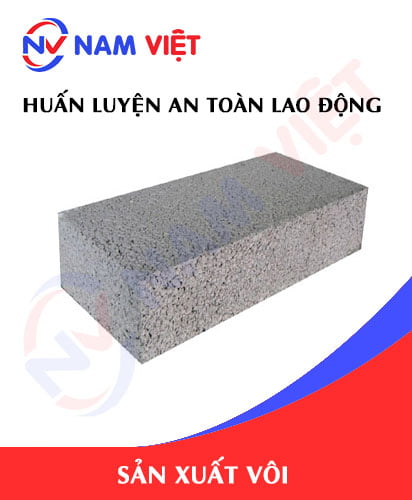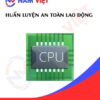Occupational safety training for concrete product manufacturing
99,000 ₫
Note: The above price is calculated per person, the price may fluctuate depending on the number of learners participating in the course and the market movement, for more accurate price support please refer to the pricing table or contact our consultants directly.
Occupational safety is an important issue in factories manufacturing concrete products and needs to be addressed promptly to ensure the health and safety of workers, enhancing the reputation of businesses. The Safety training course is one of the effective solutions to raise awareness about how to prevent occupational accidents for workers involved in manufacturing concrete products.
Table of Contents
Toggle1. Overview of concrete products
a. What are concrete products?
- Concrete products are materials manufactured from concrete or cement concrete such as concrete slabs, concrete columns, concrete foundations, concrete bricks, sidewalks, concrete paving, concrete roads, concrete partitions, concrete containers, concrete sewer pipes, and many other products.
- Concrete is a type of construction material made from main components including cement, sand, gravel, and water, which are mixed together to form a homogeneous mixture and then poured into molds to form construction material products. Concrete has high durability, good hardness, and great load-bearing capacity, so it is widely used in construction and transportation projects.

b. Types of machinery for manufacturing concrete products
The types of machinery for manufacturing concrete products include:
- Concrete mixer: used to mix the components of cement, sand, gravel, and water to create a concrete mixture.
- Concrete pump/pourer: used to pour concrete into molds to form construction material products.
- Concrete iron bender: used to bend and cut concrete iron to create columns, beams, and other reinforced concrete structures.
- Concrete vibrator: used to vibrate concrete after pouring it into the mold to remove air bubbles and create a smooth concrete surface.
- Concrete cutter: used to cut concrete into different sizes and shapes to meet the requirements of construction projects.
- Concrete sprayer: used to spray concrete onto load-bearing structures and create complex-shaped concrete products such as underpasses, bridges, etc.
- Concrete drill and cutter: used to drill and cut concrete to create holes for electrical wires, water pipes, and air ducts.
- Concrete brick machine: used to produce concrete bricks of various sizes and shapes for use in construction projects.

c. Concrete products manufacturing enterprises in Vietnam
The concrete products manufacturing enterprises in Vietnam are quite diverse, including the following names:
- Viglacera Group: is one of the largest groups in manufacturing and trading construction materials in Vietnam, including concrete products such as bricks, paving stones, and other related products.
- Coteccons Group: is one of the leading groups in the field of construction and manufacturing construction materials in Vietnam, with key products including precast concrete, cladding panels, and other concrete products.
- Quoc Cuong Gia Lai Construction and Building Materials Co., Ltd.: specializes in manufacturing and trading precast concrete products such as cladding panels, scaffolding, bored piles, reinforced concrete, and other products.
- Investment, Construction, and Building Materials Trading Joint Stock Company: specializes in manufacturing and trading precast concrete products, bored piles, reinforced concrete, bricks, paving stones, and other products.
- Ha Do Trading and Manufacturing Building Materials Co., Ltd.: specializes in manufacturing and supplying precast concrete products, bricks, paving stones, and other related products.
- Hung Phuc Building Materials Co., Ltd.: manufactures and trades precast concrete products, cladding panels, bored piles, reinforced concrete, and other products.
- Dai Thanh Trading and Manufacturing Building Materials Co., Ltd.: specializes in manufacturing and trading precast concrete products, bricks, paving stones, and other related products.
These are just a few concrete products manufacturing enterprises in Vietnam; there are many other businesses in this industry.
d. Specific jobs in a concrete products factory
Group 1
- Executive director, deputy executive director, department head in a concrete products factory.
Group 2
- Safety officer: manages safety in the factory, designs safety procedures, supervises and urges employees to comply with safe work procedures.
Group 3
- Raw material preparation: Raw materials for manufacturing concrete include cement, sand, stone, and water. The work of preparing raw materials includes selecting and transporting materials from storage to the manufacturing factory.
- Concrete mixing: After all the raw materials have been prepared, the next job is mixing the concrete. Concrete mixers will mix the ingredients according to a special ratio and mixing method to create a standard type of concrete.
- Molding: After the concrete has been mixed, workers will pour the concrete into molds. Molds are usually made of steel or composite plastic.
- Product drying: After molding, concrete products will be dried in a special drying chamber. The drying process helps concrete products achieve optimal hardness and durability.
- Quality inspection: Each concrete product will be quality-checked before being released to the market. Inspection standards include durability, dimensional accuracy, smoothness, and color.
- Packaging and transportation: After quality inspection is completed, concrete products will be packaged and transported to dealers or end customers.
Group 4
- Office jobs, serving, sales, marketing.
- Production management, quality management, human resource management, material management, financial accounting management.
- Research and development of new products, designing product packaging.

2. Overview of the safety training course for manufacturing concrete products
Within the scope of this article, we focus on issues related to Group 3, because Group 3 is the group directly involved in the production process, bearing the highest risk of labor accidents. Refer to other groups here
a. What is Group 3 safety training?
- Safety training for Group 3 are classes that equip workers with awareness of how to prevent labor accidents.
- The safety training course will help workers recognize and avoid dangers, limiting the risks of labor accidents while working.
REGISTER FOR LABOR SAFETY TRAINING SERVICE
b. Training duration
Initial safety training duration
- The total training duration is at least 24 hours, including the test time.
- 8 hours of theoretical study on the policy system and laws on labor safety and hygiene
- 8 hours of theoretical study on basic knowledge of labor safety and hygiene
- 4 hours of theoretical study on specialized training content
- 2 hours of practical study on specialized training content
- 2 hours of theoretical test at the end of the training course
The safety training center will distribute the time into several training sessions depending on the time arrangement for the staff. However, there will usually be 6 training sessions, the course will last 3 days, on the condition that the manufacturing enterprise can arrange continuous study time.
Periodic safety training duration
- Before the labor safety card expires, if the worker wants to get it re-issued, they must go through a periodic labor safety training course, with a periodic safety training duration of at least 50% of the initial safety training duration.
Explanation: The total periodic labor safety training duration is at least 12 hours, including the test time. After completing the periodic training course and passing the test, workers will be re-issued or have their labor safety card extended.
c. Content of the training course
| No. | TRAINING CONTENT | TRAINING DURATION (HOURS) | |||
| Total | Of which | ||||
| Theory | Practice | Test | |||
| I | Policy and legal system on labor safety and hygiene | 8 | 8 | 0 | 0 |
| 1 | Overview of the legal document system on labor safety and hygiene. | 6 | 6 | ||
| 2 | System of technical standards and regulations on labor safety and hygiene. | 1 | 1 | ||
| 3 | Specific regulations of state management agencies on labor safety and hygiene when newly building, expanding or renovating projects, facilities for manufacturing, using, preserving, storing and inspecting types of machinery, equipment, materials, and substances with strict requirements on labor safety and hygiene. | 1 | 1 | ||
| II | Basic knowledge of labor safety and hygiene | 8 | 8 | 0 | 0 |
| 1 | Basic knowledge of hazardous and harmful factors at the workplace. | 4 | 4 | ||
| 2 | Methods to improve working conditions. | 1 | 1 | ||
| 3 | Safety culture in manufacturing and business. | 1 | 1 | ||
| 4 | Rights and obligations of the employer, the employee; policies and regulations on labor safety and hygiene for employees; functions and duties of the safety and hygiene network. | 1 | 1 | ||
| 5 | Labor safety and hygiene regulations, safety and hygiene signs and instructions, and the use of safety equipment and personal protective equipment; professional skills in first aid for labor accidents, and prevention of occupational diseases. | 1 | 1 | ||
| III | Specialized training content | 6 | 4 | 2 | 0 |
| General knowledge about types of machinery, equipment, and substances that generate hazardous and harmful factors; analysis, assessment, and management of labor safety and hygiene risks, safe work procedures with machinery, equipment, and substances that have strict requirements on labor safety and hygiene. | 6 | 4 | 2 | ||
| IV | Safety training test at the end of the training course | 2 | 2 | 0 | 0 |
| Total | 24 | 22 | 2 | ||
See more training content for 6 groups
d. Labor safety card
After completing the labor safety training course and passing the test, workers will be issued a labor safety card (in practice, also known as a Group 3 labor safety certificate).
The Group 3 safety card will clearly show information such as: full name, date of birth, specific job and working environment. It also includes the training duration, a red seal, and a signature confirming the completion of the training course.
According to the regulations for issuing safety cards specified in Clause 2 of Article 24 of Decree 44/2016/ND-CP, there are two cases:
- If the employer and the employee have a labor contract, the employer must sign, seal, and laminate the safety card for the trained person in Group 3 after they have completed the training course from the training unit and passed the test.
- If the worker is a freelancer or seasonal worker and does not have a labor contract, the training unit must sign, seal, and laminate the safety card for the worker after they have completed the training course from the labor safety training unit and passed the test.

3. Identifying hazards affecting workers when manufacturing concrete products
The hazards affecting workers when manufacturing concrete products may include:
- Concrete products manufacturing machinery can pose a danger to workers if not used correctly. These dangers include being hit, touching moving parts of the machine, and getting stuck between machine parts.
- The manufacturing of concrete can generate many liquids and dust such as cement, sand, stone, fly ash, etc. If not used correctly, these liquids and dust can be harmful to workers’ health if inhaled or if they come into direct contact with the skin.
- When manufacturing concrete products, workers have to move and lift heavy materials such as concrete and steel. This can cause back pain, injuries, and fatigue for workers.
- Workers involved in manufacturing concrete products often have to work in environments with high temperatures and high humidity. If not vigilant enough, workers may suffer from heatstroke or dehydration when working for a long time.
- When working in a concrete products factory, workers can suffer from labor accidents due to many different reasons, including falling heavy objects, being punctured, falling from a height, and being stuck between machine parts.
- If the electrical equipment in the factory is not regularly maintained, not properly insulated, and not waterproof, it will pose a risk of electric shock to workers during the manufacturing process.
4. Types of labor accidents that often occur to workers when manufacturing concrete products
The types of labor accidents that often occur to workers in a concrete products factory include:
- Accidents during material transportation: When transporting materials from one place to another, workers may face dangers from moving heavy and bulky equipment.
- Accidents when performing concrete pressing: This is a job that requires high precision, and improper operation can cause accidents such as falling materials, loss of balance, etc.
- Accidents due to material spillage: Handling concrete and other materials in the manufacturing of concrete products can cause dangers from liquids and dust, especially in confined spaces with poor ventilation.
- Accidents when using machinery: The machinery used in manufacturing concrete products such as concrete mixers, concrete cutters, presses, etc. can cause accidents if not operated correctly and maintained periodically.
- Accidents when performing construction work: Workers involved in manufacturing concrete products may perform construction work such as installing reinforced steel, laying pipes, pouring concrete, etc. These jobs can pose dangers if not performed correctly and if personal protective equipment such as hard hats, gloves, etc. is not used.

5. Safety measures when participating in the manufacturing of concrete products
Safety measures when participating in the manufacturing of concrete products include:
- Ensure personal protective equipment: Workers must be provided with full personal protective equipment such as hard hats, safety glasses, face masks, gloves, protective clothing, safety shoes, safety belts, etc.
- Training and education: Workers need to be trained and educated on safety measures when working at the concrete products factory. Investors need to be responsible for ensuring that workers are fully trained and educated before starting work.
- Use safe machinery: The use of safe machinery is very important to minimize labor accidents. Safe equipment and machinery should be used, maintained periodically, and operated correctly.
- Inspect and maintain equipment: Workers need to regularly inspect equipment and machinery before use to ensure they are working well and are safe. In addition, periodic maintenance is necessary to avoid technical faults.
- Create a safe working space: A safe working space needs to be created for workers by minimizing the risks caused by harmful agents and natural factors such as noise, dust, humidity, etc.
- Perform monitoring and quality control: Concrete products manufacturing companies need to perform monitoring and quality control to ensure products meet quality standards. In addition, periodic inspection and evaluation methods need to be implemented to ensure worker safety.
- Periodically organize work environment monitoring in the factory to collect and analyze harmful factors for workers, thereby adjusting to reduce the harm level to prevent occupational diseases for them.
6. Benefits of safety training for manufacturing concrete products
An Toan Nam Viet provides businesses with great benefits after completing labor safety training courses as regulated in Decree 44/2016/ND-CP on labor safety and hygiene.
- Workers can recognize the potential risks of labor accidents, and from there, have preventive measures to avoid labor accidents.
- Businesses can establish risk prevention measures in their production, operation, and maintenance processes.
- Costs incurred when unsafe situations occur in labor are minimized.
- Uninterrupted production processes will help increase labor productivity and product quality.
- Compliance with labor safety laws, avoiding legal risks.
- Building a professional and reputable image in all aspects, thereby enhancing the brand for your business.
Nam Viet’s training courses are the solution to prevent and combat external factors that can lead to danger for each individual, which could result in injury or, more seriously, death.
REGISTER FOR LABOR SAFETY TRAINING SERVICE
7. Customer feedback after completing the safety training course for manufacturing concrete products
An Toan Nam Viet has many years of experience in the mission of accompanying many businesses in Vietnam in general and in the southern provinces in particular. And that responsibility is something extremely valuable to Nam Viet, which is why Nam Viet’s Labor Safety Training work is always focused on becoming more and more professional. The motivation for An Toan Nam Viet to grow strong to this day comes from the positive feedback and suggestions from businesses. Below are the responses from our partners whom we have served.
Bac Nam E&C Investment and Construction Joint Stock Company
“The first time I used the service at An Toan Nam Viet, I was very surprised by the enthusiastic 24/7 support of the consulting team. The class organization was very fast and convenient for our company, thank you very much for Nam Viet’s service!”
Hoa Dat Construction and Trading Joint Stock Company
“Nam Viet’s service has helped us a lot in simplifying labor safety and the process of completing safety records for our work. The consulting team is enthusiastic and timely in answering our questions. 5 stars for Nam Viet”
See more customer interviews after using An Toan Nam Viet’s service
8. An Toan Nam Viet’s Labor Safety Training capacity
An Toan Nam Viet is a reputable and quality labor safety training center in Vietnam today. With labor safety training sessions taking place continuously at manufacturing workshops, factories, or construction sites across the country (63 provinces in Vietnam).
REGISTER FOR LABOR SAFETY TRAINING SERVICE
License for labor safety training
- An Toan Nam Viet has been inspected and licensed by the Department of Labor Safety of the Ministry of Labor – Invalids and Social Affairs, which issued a certificate of eligibility to operate in labor safety and hygiene training. This further strengthens our capacity for labor safety training.

Documents and lectures
- Before the labor safety training documents are put into the labor safety training courses, they have been reviewed and approved to ensure that the lectures are accurate in knowledge and effective when applied.
- The teaching method of the lecturers is synchronized according to the teaching standards of An Toan Nam Viet, which is a method that experts in labor safety and hygiene training have researched and concluded during the teaching process to bring the highest knowledge absorption efficiency to students.
Facilities
- Controlling the factors in the classroom that affect the training process will increase the teaching performance and the knowledge absorption efficiency of students.
- Our training course supporting facilities always have spacious classrooms that meet standards for area, lighting, training equipment, etc.
9. Reputable and quality safety training center nationwide
At An Toan Nam Viet, we always prioritize our professional dedication to labor safety training. To us, conveying knowledge on self-protection to workers so that they can have a safe journey on their livelihoods is a contribution to building the country.
To ensure effective training, we carefully and meticulously prepare every small detail. From preparing tools, equipment, and teaching devices to textbooks, documents, sound, and lighting.
Our labor safety training lecturers are experts with many years of experience in the field. They even have research projects on identifying dangers in all occupations and how to prevent them.
The lecturers’ lectures are drawn from practice and are conveyed in the most vivid and easy-to-visualize way for workers. These factors help workers feel comfortable during the study period and absorb our taught knowledge well. Of course, the knowledge conveyed always closely follows Decree 44/2016/ND-CP.
From there, they grasp many measures to prevent dangers and how to protect themselves. At the same time, they also apply them in the most suitable way in their actual work.
Our safety training center is proud to be a reputable and professional provider of labor safety training services with the following advantages:
- Competitive training costs but training quality is still ensured.
- Flexible training schedule to suit the production situation of the company.
- The procedure for issuing labor safety training certificates is fast and in accordance with the law.
- The training lecturers are people with many years of experience in the profession.
- The classroom is controlled for factors that affect the training process to increase teaching performance and knowledge absorption efficiency of students.
- The lectures are compiled to be suitable for labor safety work at businesses.
- An Toan Nam Viet works with dedication and professionalism to support customers accurately and quickly.

10. See more reference materials for safety training for manufacturing concrete products
- Safety documents for manufacturing concrete products
- Set of safety training documents
- Set of labor safety training test questions
- Multiple-choice test on labor safety for manufacturing concrete products
- Slides for labor safety training lecture for manufacturing concrete products
1 review for Occupational safety training for concrete product manufacturing
No comments yet















namchinh.haiphong341
Hài lòng nhé!